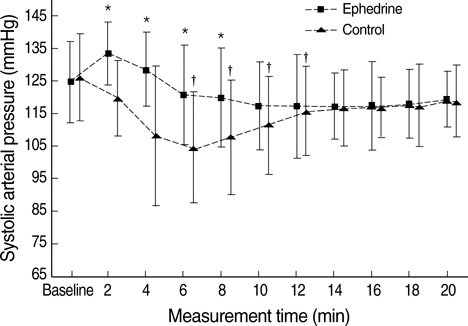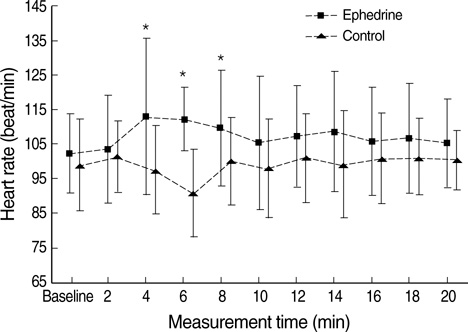J Korean Med Sci.
2009 Oct;24(5):883-888. 10.3346/jkms.2009.24.5.883.
The Effects of Intravenous Ephedrine During Spinal Anesthesia for Cesarean Delivery: A Randomized Controlled Trial
- Affiliations
-
- 1Department of Anesthesiology, Cumhuriyet University School of Medicine, Sivas, Turkey. driclal@gmail.com
- 2Department of Obstetrics and Gynecology, Cumhuriyet University School of Medicine, Sivas, Turkey.
- KMID: 1782011
- DOI: http://doi.org/10.3346/jkms.2009.24.5.883
Abstract
- We designed a randomized, double-blinded study to determine the efficacy and safety of 0.5 mg/kg intravenous ephedrine for the prevention of hypotension during spinal anesthesia for cesarean delivery. Patients were randomly allocated into two groups: ephedrine group (n=21) and control group (n=21). Intravenous preload of 15 mL/kg lactated Ringer's solution was given. Shortly after the spinal injection, ephedrine 0.5 mg/kg or saline was injected intravenous for 60 sec. The mean of highest and lowest heart rate in the ephedrine group was higher than those of control group (P<0.05). There were significant lower incidences of hypotension and nausea and vomiting in the ephedrine group compared with the control group (8 [38.1%] vs. 18 [85.7%]); (4 [19%] vs. 12 [57.1%], respectively) (P<0.05). The first rescue ephedrine time in the ephedrine group was significantly longer (14.9+/-7.1 min vs. 7.9+/-5.4 min) than that of the control group (P<0.05). Neonatal outcome were similar between the study groups. These findings suggest, the prophylactic bolus dose of 0.5 mg/kg intravenous ephedrine given at the time of intrathecal block after a crystalloid fluid preload, plus rescue boluses reduce the incidence of hypotension.
Keyword
MeSH Terms
-
Adult
*Anesthesia, Spinal/adverse effects
Blood Pressure/drug effects
*Cesarean Section
Ephedrine/administration & dosage/*therapeutic use
Female
Heart Rate/drug effects
Humans
Hypotension/chemically induced/prevention & control
Injections, Intravenous
Postoperative Nausea and Vomiting/prevention & control
Pregnancy
Vasoconstrictor Agents/administration & dosage/*therapeutic use
Figure
Cited by 2 articles
-
The relationship between symphysis-fundal height and intravenous ephedrine dose in spinal anesthesia for elective cesarean section
Sung Hee Chung, Hyeon Jeong Yang, Jong-Yeon Lee, Kum-Hee Chung, Duk-Hee Chun, Byeong-Kuk Kim
Korean J Anesthesiol. 2010;59(3):173-178. doi: 10.4097/kjae.2010.59.3.173.Comparison of spinal anesthesia dosage based on height and weight versus height alone in patients undergoing elective cesarean section
Khalid Maudood Siddiqui, Muhammad Asghar Ali, Hameed Ullah
Korean J Anesthesiol. 2016;69(2):143-148. doi: 10.4097/kjae.2016.69.2.143.
Reference
-
1. Park GE, Hauch MA, Curlin F, Datta S, Bader AM. The effects of varying volumes of crystalloid administration before cesarean delivery on maternal hemodynamics and colloid osmotic pressure. Anesth Analg. 1996. 83:299–303.
Article2. Cheun JK, Kim AR. Intrathecal meperidine as the sole agent for cesarean section. J Korean Med Sci. 1989. 4:135–138.
Article3. Rout CC, Rocke DA, Levin J, Gouws E, Reddy D. A reevaluation of the role of crystalloid preload in the prevention of hypotension associated with spinal anesthesia for elective cesarean section. Anesthesiology. 1993. 79:262–269.
Article4. Clark SL, Cotton DB, Pivarnik JM, Lee W, Hankins GD, Benedetti TJ, Phelan JP. Position change and central hemodynamic profile during normal third-trimester pregnancy and post partum. Am J Obstet Gynecol. 1991. 164:883–887.
Article5. Webb AA, Shipton EA. Re-evaluation of i.m. ephedrine as prophylaxis against hypotension associated with spinal anaesthesia for Caesarean section. Can J Anaesth. 1998. 45:367–369.
Article6. Husaini SW, Russell IF. Volume preload: lack of effect in the prevention of spinal-induced hypotension at caesarean section. Int J Obstet Anesth. 1998. 7:76–81.
Article7. Chan WS, Irwin MG, Tong WN, Lam YH. Prevention of hypotension during spinal anaesthesia for caesarean section: ephedrine infusion versus fluid preload. Anaesthesia. 1997. 52:908–913.
Article8. King SW, Rosen MA. Prophylactic ephedrine and hypotension associated with spinal anesthesia for cesarean delivery. Int J Obstet Anesth. 1998. 7:18–22.
Article9. Lee A, Ngan Kee WD, Gin T. A dose-response meta-analysis of prophylactic intravenous ephedrine for the prevention of hypotension during spinal anesthesia for elective cesarean delivery. Anesth Analg. 2004. 98:483–490.
Article10. Ngan Kee WD, Khaw KS, Lee BB, Lau TK, Gin T. A dose-response study of prophylactic intravenous ephedrine for the prevention of hypotension during spinal anesthesia for cesarean delivery. Anesth Analg. 2000. 90:1390–1395.11. Rout CC, Rocke DA. Prevention of hypotension following spinal anesthesia for cesarean section. Int Anesthesiol Clin. 1994. 32:117–135.
Article12. Thomas DG, Robson SC, Redfern N, Hughes D, Boys RJ. Randomized trial of bolus phenylephrine or ephedrine for maintenance of arterial pressure infusion during spinal anaesthesia for Caesarean section. Br J Anaesth. 1996. 76:61–65.13. LaPorta RF, Arthur GR, Datta S. Phenylephrine in treating maternal hypotension due to spinal anaesthesia for caesarean delivery: effects on neonatal catecholamine concentrations, acid base status and Apgar scores. Acta Anaesthesiol Scand. 1995. 39:901–905.14. Hall PA, Bennett A, Wilkes MP, Lewis M. Spinal anaesthesia for caesarean section: comparison of infusions of phenylephrine and ephedrine. Br J Anaesth. 1994. 73:471–474.
Article15. Desalu I, Kushimo OT. Is ephedrine infusion more effective at preventing hypotension than traditional prehydration during spinal anaesthesia for caesarean section in African parturients? Int J Obstet Anesth. 2005. 14:294–299.
Article16. Greiss FC, Crandell DL. Therapy for hypotension induced by spinal anesthesia during pregnancy: observations on gravid ewes. JAMA. 1965. 191:793–796.17. Lee A, Ngan Kee WD, Gin T. A quantitative, systematic review of randomized controlled trials of ephedrine versus phenylephrine for the management of hypotension during spinal anesthesia for cesarean delivery. Anesth Analg. 2002. 94:920–926.
Article18. Loughrey JP, Yao N, Datta S, Segal S, Pian-Smith M, Tsen LC. Hemodynamic effects of spinal anesthesia and simultaneous intravenous bolus of combined phenylephrine and ephedrine versus ephedrine for cesarean delivery. Int J Obstet Anesth. 2005. 14:43–47.
Article19. Critchley LA, Stuart JC, Conway F, Short TG. Hypotension during subarachnoid anaesthesia: haemodynamic effects of ephedrine. Br J Anaesth. 1995. 74:373–378.
Article20. Jackson R, Reid JA, Thorburn J. Volume preloading is not essential to prevent spinal-induced hypotension at caesarean section. Br J Anaesth. 1995. 75:262–265.
Article21. Kang YG, Abouleish E, Caritis S. Prophylactic intravenous ephedrine infusion during spinal anesthesia for cesarean section. Anesth Analg. 1982. 61:839–842.
Article22. Lee A, Ngan Kee WD, Gin T. Prophylactic ephedrine prevents hypotension during spinal anesthesia for cesarean delivery but does not improve neonatal outcome: a quantitative systematic review. Can J Anaesth. 2002. 49:588–599.
Article23. Owczuk R, Sawicka W, Wujtewicz MA, Kawecka A, Lasek J, Wujtewicz M. Influence of spinal anesthesia on corrected QT interval. Reg Anesth Pain Med. 2005. 30:548–552.
Article24. Veering BT, Cousins MJ. Cardiovascular and pulmonary effects of epidural anaesthesia. Anaesth Intensive Care. 2000. 28:620–635.
Article25. Simon L, Provenchére S, de Saint Blanquat L, Boulay G, Hamza J. Dose of prophylactic intravenous ephedrine during spinal anesthesia for cesarean section. J Clin Anesth. 2001. 13:366–369.
Article26. Wright RG, Shnider SM, Levinson G, Rolbin SH, Parer JT. The effect of maternal administration of ephedrine on fetal heart rate and variability. Obstet Gynecol. 1981. 57:734–738.
Article27. Shearer VE, Ramin SM, Wallace DH, Dax JS, Gilstrap LC 3rd. Fetal effects of prophylactic ephedrine and maternal hypotension during regional anesthesia for cesarean section. J Matern Fetal Med. 1996. 5:79–84.
Article28. Eisler G, Hjertberg R, Lagercrantz H. Randomised controlled trial of effect of terbutaline before elective caesarean section on postnatal respiration and glucose homeostasis. Arch Dis Child Fetal Neonatal Ed. 1999. 80:F88–F92.
Article
- Full Text Links
- Actions
-
Cited
- CITED
-
- Close
- Share
- Similar articles
-
- Prophylactic intravenous ephedrine infusion during spinal anesthesia for cesarean section
- Management of hypotension after spinal anesthesia administered for caesarean section
- Comparison of maternal and fetal effects of ephedrine, phenylephrine, and combination infusion during spinal anesthesia for cesarean delivery
- The Effect of Fluid Preloading and Ephedrine Administration for Prevention of Hypotension during Spinal Anesthesia for Cesarean Delivery
- Combined spinal-epidural anesthesia for cesarean section in a patient with Moyamoya disease: A case report




